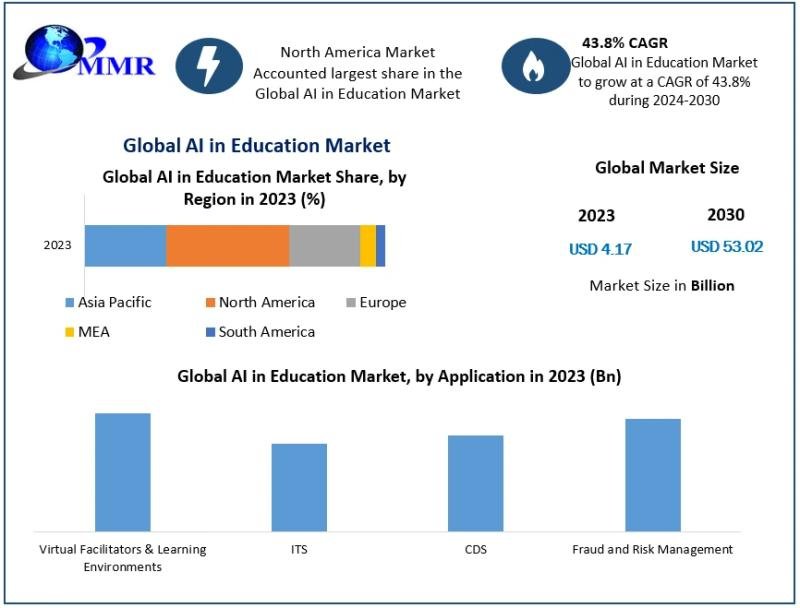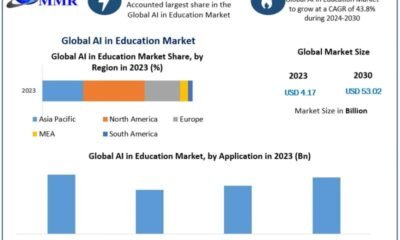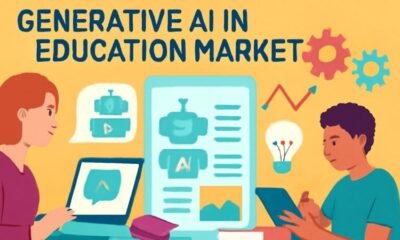Education
Voice AI in Education Market Is Going to Boom

HTF MI just released the Global Voice AI in Education Market Study, a comprehensive analysis of the market that spans more than 143+ pages and describes the product and industry scope as well as the market prognosis and status for 2025-2032. The marketization process is being accelerated by the market study’s segmentation by important regions. The market is currently expanding its reach.
Major companies profiled in Voice AI in Education Market are: Google, Amazon (Alexa), Microsoft, IBM Watson, Nuance, Baidu, iFlytek, SoundHound, Sensory Inc, Smart Sparrow, Carnegie Learning, LinguaLeo, Speechace, Deepgram, ReadSpeaker, ELSA Speak, Sonantic, Soapbox Labs, Voiceitt, Sestek.
Request PDF Sample Copy of Report: (Including Full TOC, List of Tables & Figures, Chart): https://www.htfmarketinsights.com/sample-report/4377851-voice-ai-in-education-market?utm_source=Altab_OpenPR&utm_id=Altab
HTF Market Intelligence projects that the global Voice AI in Education market will expand at a compound annual growth rate (CAGR) of 26.5% from 2025 to 2033, from USD 1.2 Billion in 2025 to USD 7.9 Billion by 2033.
The following Key Segments Are Covered in Our Report
By Type
Voice-enabled tutoring, Language learning assistants, Smart classrooms, Speech-to-text systems, Interactive reading tools
By Application
Language learning, Accessibility for disabled, Virtual classrooms, Personalized tutoring, Test prep
Definition: Voice AI in education refers to the use of speech recognition and natural language processing (NLP) technologies to facilitate learning and communication between students and educational platforms. Voice AI enables interactive language learning, assists students with disabilities, automates administrative tasks, and supports personalized tutoring. With the rise of smart devices, conversational AI, and accessibility requirements, educational institutions are adopting voice-based solutions to make learning more inclusive and engaging.
Market Trends:
• Conversational AI in classrooms, Multilingual support, Gamified voice learning, Integration with LMS, Voice biometrics
Market Drivers:
• AI adoption in education, Rising need for personalized learning, Growth of voice-enabled devices, Inclusivity goals, EdTech boom
Market Challenges:
• Privacy concerns, Accent recognition issues, High development cost, Data security, Low adoption in rural schools
Dominating Region:
North America
Fastest-Growing Region:
Asia-Pacific
Buy Now Latest Edition of Voice AI in Education Market Report: https://www.htfmarketinsights.com/buy-now?format=1&report=4377851
The titled segments and sub-section of the market are illuminated below:
In-depth analysis of Voice AI in Education market segments by Types: Voice-enabled tutoring, Language learning assistants, Smart classrooms, Speech-to-text systems, Interactive reading tools
Detailed analysis of Voice AI in Education market segments by Applications: Language learning, Accessibility for disabled, Virtual classrooms, Personalized tutoring, Test prep
Geographically, the detailed analysis of consumption, revenue, market share, and growth rate of the following regions:
• The Middle East and Africa (South Africa, Saudi Arabia, UAE, Israel, Egypt, etc.)
• North America (United States, Mexico & Canada)
• South America (Brazil, Venezuela, Argentina, Ecuador, Peru, Colombia, etc.)
• Europe (Turkey, Spain, Turkey, Netherlands Denmark, Belgium, Switzerland, Germany, Russia UK, Italy, France, etc.)
• Asia-Pacific (Taiwan, Hong Kong, Singapore, Vietnam, China, Malaysia, Japan, Philippines, Korea, Thailand, India, Indonesia, and Australia).
Have different Market Scope & Business Objectives; Enquire for customized study: https://www.htfmarketinsights.com/report/4377851-voice-ai-in-education-market?utm_source=Altab_OpenPR&utm_id=Altab
Voice AI in Education Market Research Objectives:
– Focuses on the key manufacturers, to define, pronounce and examine the value, sales volume, market share, market competition landscape, SWOT analysis, and development plans in the next few years.
– To share comprehensive information about the key factors influencing the growth of the market (opportunities, drivers, growth potential, industry-specific challenges and risks).
– To analyze the with respect to individual future prospects, growth trends and their involvement to the total market.
– To analyze reasonable developments such as agreements, expansions new product launches, and acquisitions in the market.
– To deliberately profile the key players and systematically examine their growth strategies.
FIVE FORCES & PESTLE ANALYSIS:
In order to better understand market conditions five forces analysis is conducted that includes the Bargaining power of buyers, Bargaining power of suppliers, Threat of new entrants, Threat of substitutes, and Threat of rivalry.
• Political (Political policy and stability as well as trade, fiscal, and taxation policies)
• Economical (Interest rates, employment or unemployment rates, raw material costs, and foreign exchange rates)
• Social (Changing family demographics, education levels, cultural trends, attitude changes, and changes in lifestyles)
• Technological (Changes in digital or mobile technology, automation, research, and development)
• Legal (Employment legislation, consumer law, health, and safety, international as well as trade regulation and restrictions)
• Environmental (Climate, recycling procedures, carbon footprint, waste disposal, and sustainability)
Get customized report 👉 https://www.htfmarketinsights.com/customize/4377851-voice-ai-in-education-market?utm_source=Altab_OpenPR&utm_id=Altab
Points Covered in Table of Content of Global Voice AI in Education Market:
Chapter 01 – Voice AI in Education Executive Summary
Chapter 02 – Market Overview
Chapter 03 – Key Success Factors
Chapter 04 – Global Voice AI in Education Market – Pricing Analysis
Chapter 05 – Global Voice AI in Education Market Background or History
Chapter 06 – Global Voice AI in Education Market Segmentation (e.g. Type, Application)
Chapter 07 – Key and Emerging Countries Analysis Worldwide Voice AI in Education Market
Chapter 08 – Global Voice AI in Education Market Structure & worth Analysis
Chapter 09 – Global Voice AI in Education Market Competitive Analysis & Challenges
Chapter 10 – Assumptions and Acronyms
Chapter 11 – Voice AI in Education Market Research Methodology
Thanks for reading this article; you can also get individual chapter-wise sections or region-wise report versions like North America, LATAM, Europe, Japan, Australia or Southeast Asia.
Contact Us:
Nidhi Bhavsar (PR & Marketing Manager)
HTF Market Intelligence Consulting Private Limited
Phone: +15075562445
sales@htfmarketreport.com
About Author:
HTF Market Intelligence Consulting is uniquely positioned to empower and inspire with research and consulting services to empower businesses with growth strategies, by offering services with extraordinary depth and breadth of thought leadership, research, tools, events, and experience that assist in decision-making.
This release was published on openPR.
Education
How much AI in schools? Educators wrangle with a quickly evolving tech question

How much should artificial intelligence be in classrooms?
As AI becomes more pervasive, getting included in many software apps without the possibility to remove it, educators across the region have different answers to questions about AI in schools.
Teachers have been using it to help develop lesson plans and quizzes, helping to save time in the work day. A presidential directive seeks to make teacher use of AI much more prevalent — President Donald Trump signed an executive order for more AI throughout K-12 education.
Students have been exploring it, using popular apps such as ChatGPT to help study for assignments — or even to just do the assignment. Some children are even turning to AI for companionship.
Springfield Public Schools prevents students from using most AI chatbots on school-issued devices and loops detection of student AI use in with many other tactics for focusing on teacher-student relationships. A Missouri State University educator in its College of Education said there is not a lot of AI-specific training for teachers available right now.
And a man who helped create a new private school in Springfield wants to see AI taught much more.
Rob Blevins, co-founder of Discovery School, has launched the National Institute for Artificial Intelligence in Education, a Springfield-based group that seeks to make the U.S. a global leader in K-12 AI education. The group has goals of advocating for AI educational learning standards, better training, more certification and developing bipartisan legislation for states.
The group already has initial support from U.S. Rep. Eric Burlison, Blevins said.
“There are no learning standards for AI,” Blevins said. “It’s here, people are using it and it’s not going to go anywhere. The best thing to do is get in front of it, and figure out how to handle it as responsibly as possible.”
AI: Vast applications for new technology
AI isn’t limited to one type of application.
Well-known chat apps such as ChatGPT and DeepSeek allow users to ask general questions and receive back lengthy answers.
Popular software apps from companies such as Microsoft and Adobe now offer AI functions to summarize large documents or help write rough drafts.
On our phones, Android’s Gemini and Apple’s Apple Intelligence fuel on-board, in-app AI searches within schedules, contacts and other uses.
Even social networks such as Facebook and X (formerly known as Twitter) have their own AI apps.
In general, these AI apps go far beyond a search engine — they are capable of answering conversational questions by processing a colossal amount of information available on the internet. They can also create content: They can write rough drafts of papers or create images based on a user’s needs.
What AI has in powerful data processing, it lacks in discernment.
It has been criticized for incorporating data from racists and other political actors in its results. It has also been criticized for causing damage to the environment, as the computers responsible for crunching all that data require more and more power.
It has also been used to create fake images and bizarre stories not rooted in reality, blurring the line between truth and fiction. For instance, the same president who signed an executive order to increase AI training and data centers also blamed it for an image of someone throwing something out of a White House window.
New nonprofit would like to see more AI in schools
Blevins hopes his group can emphasize the key part of using AI: remembering that we are the humans in charge of discerning and directing how results are used.
It’s something that Blevins remembers every time he uses such an app, he said.
“Being able to be the human who determines what’s appropriate, not the machine,” Blevins said. “I always try to tell it that, ‘Hey, I’m the human, my job is to figure this part out. You’re supposed to give me data.’”
His plans for his nonprofit include several goals:
• Creating a school recognition and certification program to help embed AI across curriculum, training and other student experiences.
• Hosting a debate tournament, where students score points from how they prompt, defend and navigate AI-generated arguments around real-world issues.
• Organizing a show that combines a science fair with a career expo.
SPS: Teachers’ toolbox for working with students can handle AI cheating concerns
Springfield Public Schools handles AI like any other technology used by students and teachers: carefully, with an eye on teaching students how to make effective use of such tools.

“It’s technology that has been around for a long time,” said Bruce Douglas, chief information officer for SPS. “Our approach to technology is about just preparing students for it, knowing that there is going to be new pieces for it. There is going to be change, and that’s why we focus on critical thinking skills and how we prepare students.”
Douglas said he remembers learning about AI development when he was a student at Missouri State University more than 25 years ago. Some of his professors were doing research around the neural networks and large language models that are critical components for how AI works.
Currently in SPS, ChatGPT and many other AI tools are generally blocked from student Chromebooks and other devices, although a teacher can make a case for using an AI app for a certain type of lesson. Any evaluation for teaching students about AI is looped in with the district’s normal curriculum review process.
Like other individuals and businesses that use technology, SPS employees see the software they use incorporating more AI features prominently. The district tries to review them as they surface and focuses on what helps teachers teach students.
“The use of digital resources, whether they may or may not incorporate AI, is always about the learning goals for the students,” said Thomas Maerke, a technology integration coordinator for SPS. “The learning goals for our students are going to be what drives us forward, and it’s the actions of our dedicated and hardworking teachers that make that happen.”
But AI is already in the hands of students. Social networks such as Instagram and TikTok are filled with stories of teachers who spot how students use AI to try to get around assignments.
Douglas said that the district offers no specific training about AI use among students. Instead, it emphasizes training teachers on how to be better teachers, because the toolbox teachers use to understand the work students produce can easily spot AI assistance.
That includes simple things, such as a student’s sudden jump in quality between assignments, Douglas said. It also includes more advanced tactics of ensuring academic integrity, from verifying original sources to double-checking data.
The district’s use of virtual learning and experiences among teachers at Launch Virtual Academy have helped give SPS more experience in such areas, Douglas said.
“We emphasize the relationship between the teacher and the students so much that they know what a student is producing, and we have seen that play out in a lot of different ways,” Douglas said. “It all starts with the teacher’s understanding of the students’ work, having those conversations and getting to know students.”
The district’s curriculum review process is annual. A committee of teachers and other educators evaluate a wide variety of lessons and programs, and their first priority is to check alignment with Missouri Learning Standards — the list of core curriculum for which public schools are held accountable and reviewed by the state.
Because of their need to follow state laws in order to obtain state funding, Blevins knows that public schools will be slow to take on some of the measures he supports. He sees more opportunity with private schools. He said he has been speaking with both public and private schools across the country
Next five years for AI in schools: More tinkering as an educational tool
The pervasiveness of AI, with ubiquitous features and options popping up in popular software and apps, means that teachers and students are still exploring what it can do.
Minor Baker, director of Missouri State University’s school of teaching, learning and developmental science in the College of Education, said that he sees students testing the waters. In his position, he watches educational trends across the country, but he also observes his school-aged children.
“I think right now we are definitely in the curious application mode,” Baker said. “I think teachers are trying to figure out what parts of AI can be used for their jobs.”
AI’s time-saving promises are especially attractive to teachers who are routinely asked to add daily responsibilities to their workload. Baker said that AI can assist teachers with time-intensive tasks, such as:
• Email communications with parents, such as weekly newsletters or notes about upcoming lessons. Baker said teachers could anguish over proper grammar or addressing potential questions that could arise.
• Developing lesson plans. A teacher could spend significant time locating the perfect book for a topic or a perfect experiment for a lesson. Teachers can save hours by getting AI to pore over a vast library of options.
“Teachers spend a lot of time just locating resources such as what would be a good book to go with a particular topic,” Baker said. “Now teachers can say, ‘This is what I’m teaching, this is my learning objective, I need resources that may be readily available.’”
He agrees with SPS’ approach to training teachers on spotting AI use in students, mainly because he does not see an abundance of education about that subject.
But education will transform and adapt, Baker said. He remembers Texas Instruments’ TI-82 programmable graphing calculator and how powerful it was on its release in 1993.
“I think it’s exceptionally realistic that we will begin to tinker around the edges of using AI as a learning tool, a learning partner,” Baker said. “The calculator did not necessarily change mathematics. Certainly, AI is more expansive than the TI-82. But I also think that a lot of what we do in school can be enhanced by the use of AI when it comes to developing knowledge.”
Baker said that AI isn’t inherently bad, per se. Its ability to provide answers to questions complements a child’s inherent curiosity.
He compared it to a set of encyclopedias that his grandparents offered. He would pick a letter, such as J, and see what was inside that volume. Kids’ version of that today, he said, is they can land on a random thought about something and go down a rabbit hole to see what more they can learn.
“I think that the likelihood is that over the next five years, we’re going to find that AI is integrated into lots of what we do, and we’ll be using it as a learning partner in schools without actually changing how important teachers really are,” Baker said. “I think teachers run those relationships, and what they do personally will remain the foundation of what schools are.”
As advocates such as Blevins work for more AI, and as the White House develops its AI Action Plan, Douglas said that any plan or curriculum for beefing up AI education cannot leave teachers behind.
“One of our core beliefs is that it’s really the teacher who is going to make the impact in the student’s education,” Douglas said. “That’s the first box I always look at, how we are making sure we have great teachers in our classrooms, and then how do we support them from there? … If everything is grounded in strong curriculum led by qualified educators, those two foundational pillars then guide how tools are used to support student learning.”
There is a transformation coming, Blevins said. And he hopes that a regular education about AI will help students learn how to use it for the better.
“If we don’t teach kids how to use it responsibly, then they will learn to use it irresponsibly,” Blevins said. “AI is way more powerful than anything that we’ve experienced before. In some ways, it’s exciting, the things that are going to be possible now because of the innovations that will occur.”
Education
Greek government strikes deal with Open AI to use tools for education and start-ups

Photo: Pixabay
The government of Greece agreed a deal with US artificial intelligence firm OpenAI to make AI tools widely available for use in secondary education and small businesses.
The deal means Greek startups in areas such as healthcare, climate change and education will enjoy access to OpenAI’s technology and support for their projects. It also means Greece is expected to become the world’s first country to integrate a specialised version of the large language model ChatGPT, known as ChatGPT Edu.
Announced by OpenAI in May 2024, ChatGPT Edu is said to be able to “reason across text and vision and use advanced tools such as data analysis”, and includes advanced capabilities in interpretation, coding and mathematics, web browsing, and document summarisation.
Posting on LinkedIn, Greece’s digital policy & AI adviser to the prime minister of the Hellenic Republic, Vassilis Koutsoumpas, said that the deal would allow teachers and students across the country to “meaningfully integrate AI into classrooms, creating a digital learning environment where every child — regardless of economic or social background — can thrive”.
“Our vision is to build on this partnership and steadily continue transforming Greece into a more resilient, technologically confident hub,” Koutsoumpas said, adding:
“We need to make sure that every Greek citizen is benefiting from this tech dividend — the social and economic benefits of technology in their daily lives.”
https://www.linkedin.com/posts/activity-7369986165128630272-q2l4?utm_source=share&utm_medium=member_desktop&rcm=ACoAAARPXzwBcH1TcR2k-pCpajFg_i9U7o1luAU
OpenAI’s chief of global affairs officer, Chris Lehane, said at the announcement of the deal: “With millions of Greeks using ChatGPT on a regular basis, the country is once again showing its dedication to learning and ideas.”
Greece’s prime minister, Kyriakos Mitsotakis, also joined the announcement of the deal, along with Anthony S. Papadimitriou, president of the Onassis Foundation, a scholarship and prize programmes organisation.
Read more: Australia urged to set ‘rules of the game’ to harness the productivity potential of AI
Partnerships with government
In August earlier this year, OpenAI announced a similar partnership with the US government’s the General Services Administration (GSA), in which it made its leading frontier models available to federal employees for a year at a cost of just US$1.
OpenAI’s CEO Sam Altman said that the partnership served to deliver on US president Donald Trump’s AI Action Plan, adding that “one of the best ways to make sure AI works for everyone is to put it in the hands of the people serving the country”.
In the same month, Altman discussed the possibility of giving the UK premium access to Open AI. His and Peter Kyle, former state for science, innovation and technology and now secretary of state for business and trade, discussed giving UK residents access to the firm’s advanced product.
However, as was reported in UK newspaper The Guardian, the idea was never seriously considered due to an estimated cost £2bn (US$2.7bn).
Register now for Public Service Data.AI 18 September 2025 – London, UK
Brought to you by Global Government Forum and hosted by HM Government, Public Service Data.AI is the UK’s flagship annual event for civil servants working to unlock the power of data and artificial intelligence across government. Free to attend for all UK public servants, this event brings together digital leaders, policymakers, data specialists and service designers to explore how the effective use of data and AI can drive smarter, fairer, and more responsive public services.
From modernising digital infrastructure and fostering public trust to ensuring ethical AI procurement and improving data-sharing across departments, Public Service Data.AI 2025 will focus on the key enablers of successful digital transformation.
Find out more and register here
Ireland announces new national office for AI
On 8 September, the Irish government launched a new national office responsible for AI, known as the National Artificial Intelligence Office (NAIO).
The goal of the new unit is to position Ireland as a European leader in AI development. It is expected that a director general will be hired later this year and will act as the authority responsible for co-ordinating the EU AI Act.
Ireland’s enterprise minister, Peter Burke, said that the launch marked a “decisive step in Ireland’s digital future”, and that the office would ensure the country maintained its position “as a trusted hub for innovation and investment”.
“We all know the importance of investing in AI in a significant and cohesive way, and this office will officially lead on this, ensuring we continue to be a global leader in digital innovation and technology,” he said.
Education
Global AI in Education Market Set to Soar from USD 4.17 Billion

◉ Opening Paragraph
According to a new report by Maximize Market Research, the global AI in Education Market was valued at USD 4.17 billion in 2023 and is projected to reach USD 53.02 billion by 2030, expanding at an impressive CAGR of 43.8% over the period 2024-2030. This surge is driven by the rising application of AI technologies such as deep learning, natural language processing (NLP), and virtual learning environments across educational systems worldwide.
Download your sample copy of this report today! https://www.maximizemarketresearch.com/request-sample/63174/
◉ Key Highlights
Market Size & CAGR: Valued at USD 4.17 billion in 2023, expected to reach USD 53.02 billion by 2030; CAGR of 43.8% from 2024 to 2030.
Leading Application/Segment: Virtual Facilitators & Learning Environments dominate applications, enabling interactive, personalized, and simulation-based learning.
Fastest-Growing or Largest Regional Market: North America currently commands the largest share and is expected to maintain strong growth; Asia-Pacific to emerge as the fastest-growing region.
Key Drivers and Trends: Growth driven by demand for intelligent adaptive learning (IAL), digital content synthesis, conversational learning, cloud-based deployments lowering total ownership cost, and institutional partnerships. Restraints include slower digitization in emerging economies.
Top Companies: Key players include IBM, Microsoft, Google, AWS, Pearson, DreamBox Learning, Cognizant, Liulishuo, Blackboard, Carnegie Learning, and others.
Secure your sample copy of this report immediately!https://www.maximizemarketresearch.com/request-sample/63174/
◉ Market Outlook
The AI in education market is poised for dramatic expansion through 2030. With a global valuation jumping from USD 4.17 billion in 2023 to USD 53.02 billion by 2030, the 43.8% CAGR reflects widespread adoption of AI-enabled tools across academia and EdTech. Deployment models indicate a shift toward cloud infrastructure, which offers scalability, cost-efficiency, and infrastructure modernization, especially appealing to institutions with limited resources.
Solutions and services segments are both witnessing high traction, with Services growing at a faster pace, fueled by increased government funding and technology evolution. On the technology front, NLP is anticipated to outpace traditional deep learning and ML applications, owing to the demand for virtual assistants, multilingual support, automated assessment, and content interpretation.
◉ Regional Insights
North America holds the largest current share, supported by strong educational infrastructure, institutional EdTech investments, and presence of major tech companies such as Microsoft, Google, and IBM. It is expected to sustain robust market expansion.
Asia-Pacific is projected to grow at the fastest rate, owing to increased use of educational devices, rising adoption of AI solutions in schools and colleges, and growing interest in personalized learning. However, varying levels of digitization across countries may influence adoption pace.
◉ Key Players
Leading market participants include prominent tech firms like IBM, Microsoft, Google, AWS, and education-focused EdTech companies such as DreamBox Learning, Pearson, Cognizant, Carnegie Learning, Liulishuo, and Blackboard. These players are driving innovation through NLP-based tools, intelligent tutoring systems, and virtual facilitator platforms.
To learn more about the findings of this research, please check:https://www.maximizemarketresearch.com/market-report/global-ai-in-education-market/63174/
◉ Analyst Quote
“The AI in education market represents one of the fastest-growing segments in EdTech,” said a lead analyst at Maximize Market Research. “With a CAGR of 43.8%, AI-powered solutions-from adaptive learning platforms to conversational assistants-are transforming how knowledge is delivered and assessed. The shift toward cloud-based deployment and the rise of NLP-centric technologies signal a new era for personalized, scalable education.”
◉ Get Market Research Latest Trends
Global Ceramic Single Layer Capacitor Market https://www.maximizemarketresearch.com/market-report/global-ceramic-single-layer-capacitor-market/66900/
Global Digital Transistor Market https://www.maximizemarketresearch.com/market-report/global-digital-transistor-market/76774/
Global Radio Frequency Coaxial Connector Market https://www.maximizemarketresearch.com/market-report/global-radio-frequency-coaxial-connector-market/102895/
Loudspeaker Subwoofer Market https://www.maximizemarketresearch.com/market-report/loudspeaker-subwoofer-market/148089/
Autonomous Robot Toys Market https://www.maximizemarketresearch.com/market-report/autonomous-robot-toys-market/147254/
Global Carbon Monoxide (Co) Detector Market https://www.maximizemarketresearch.com/market-report/global-carbon-monoxide-co-detector-market/70118/
◉ Contact Maximize Market Research:
3rd Floor, Navale IT Park, Phase 2
Pune Banglore Highway, Narhe,
Pune, Maharashtra 411041, India
sales@maximizemarketresearch.com
+91 96071 95908, +91 9607365656
◉ About Maximize Market Research:
Maximize Market Research is a multifaceted market research and consulting company with professionals from several industries. Some of the industries we cover include medical devices, pharmaceutical manufacturers, science and engineering, electronic components, industrial equipment, technology and communication, cars and automobiles, chemical products and substances, general merchandise, beverages, personal care, and automated systems. To mention a few, we provide market-verified industry estimations, technical trend analysis, crucial market research, strategic advice, competition analysis, production and demand analysis, and client impact studies.
This release was published on openPR.
-

 Business2 weeks ago
Business2 weeks agoThe Guardian view on Trump and the Fed: independence is no substitute for accountability | Editorial
-
Tools & Platforms1 month ago
Building Trust in Military AI Starts with Opening the Black Box – War on the Rocks
-

 Ethics & Policy2 months ago
Ethics & Policy2 months agoSDAIA Supports Saudi Arabia’s Leadership in Shaping Global AI Ethics, Policy, and Research – وكالة الأنباء السعودية
-

 Events & Conferences4 months ago
Events & Conferences4 months agoJourney to 1000 models: Scaling Instagram’s recommendation system
-

 Jobs & Careers2 months ago
Jobs & Careers2 months agoMumbai-based Perplexity Alternative Has 60k+ Users Without Funding
-

 Podcasts & Talks2 months ago
Podcasts & Talks2 months agoHappy 4th of July! 🎆 Made with Veo 3 in Gemini
-

 Education2 months ago
Education2 months agoMacron says UK and France have duty to tackle illegal migration ‘with humanity, solidarity and firmness’ – UK politics live | Politics
-

 Education2 months ago
Education2 months agoVEX Robotics launches AI-powered classroom robotics system
-

 Funding & Business2 months ago
Funding & Business2 months agoKayak and Expedia race to build AI travel agents that turn social posts into itineraries
-

 Podcasts & Talks2 months ago
Podcasts & Talks2 months agoOpenAI 🤝 @teamganassi



















